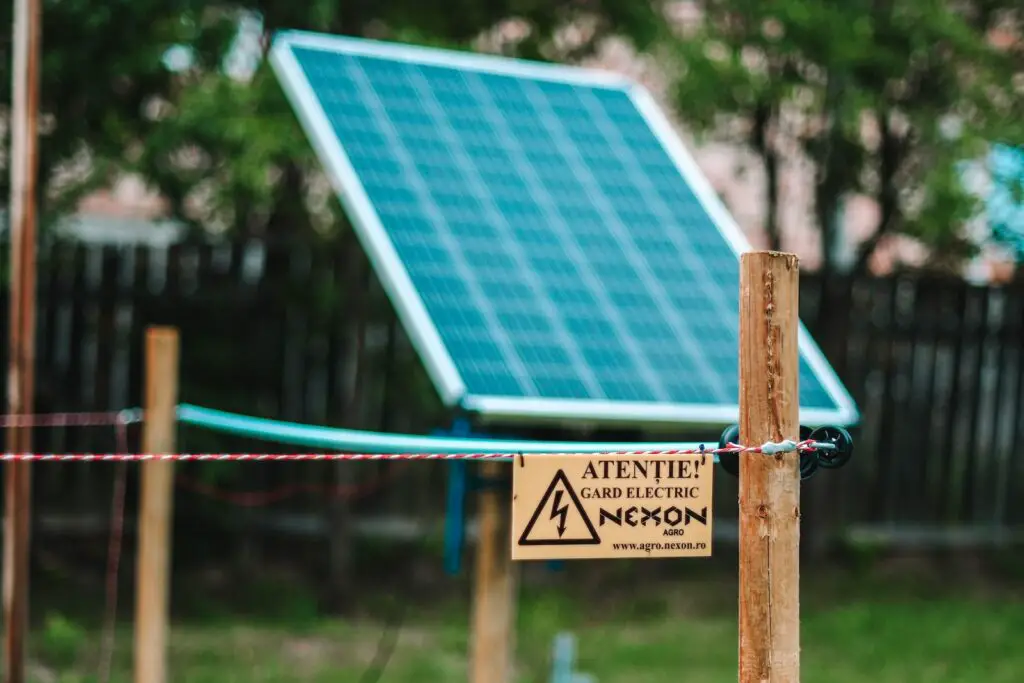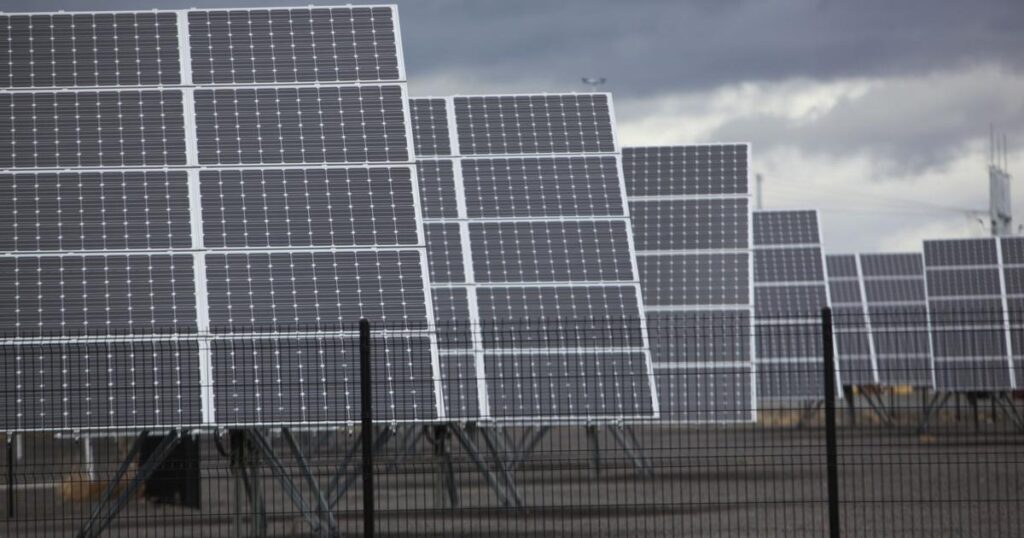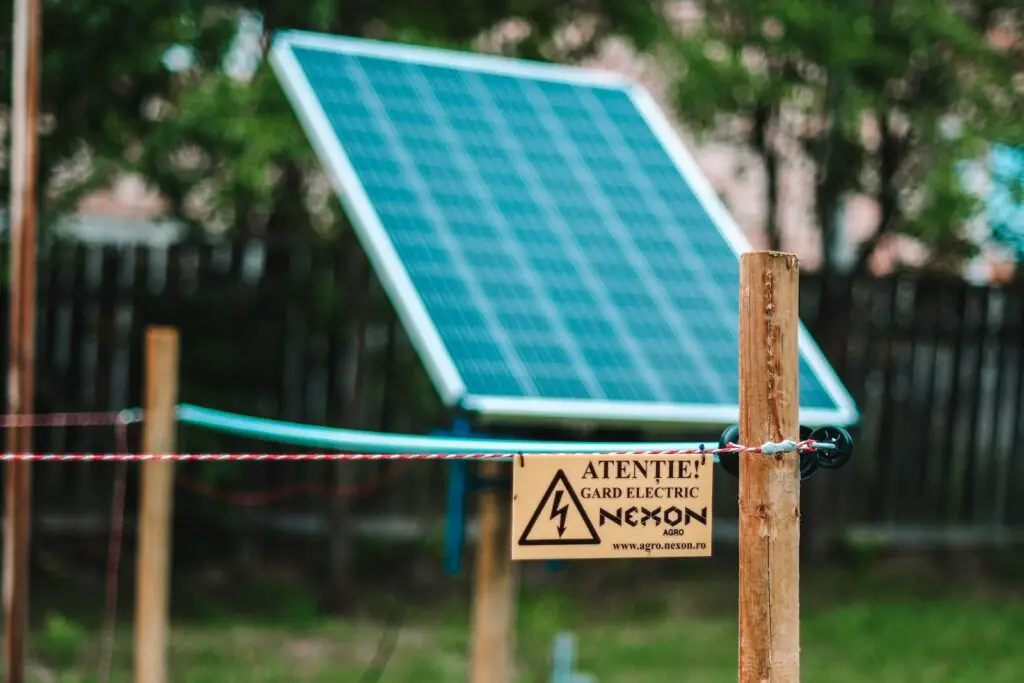Are you looking to expand your knowledge about fences? Look no further! “The Impact of Fences on Solar Panel Installations” is here to provide you with comprehensive and engaging content about fences. From different types, sizes, shapes, and materials, to their suitability for specific needs, we’ve got you covered. Our goal is to educate and guide you in making informed decisions when selecting and installing fences. Whether you’re seeking enhanced privacy, improved security, or an aesthetic addition to your property, our blog will provide valuable knowledge and practical advice. Stay tuned for 200 relevant topics that encompass the diversity of fence types, sizes, shapes, materials, and their suitability for various purposes. We’re here to make your fence-related journey a breeze!

The Impact of Fences on Solar Panel Installations
Introduction to Solar Panel Installations
Solar panel installations have become increasingly popular as a renewable energy solution for both residential and commercial properties. By harnessing the power of the sun, solar panels can generate electricity and reduce reliance on traditional energy sources. However, the presence of fences can significantly impact the efficiency and effectiveness of solar panel installations. Therefore, it is crucial to understand the relationship between fences and solar panels to ensure optimal performance and maximize the benefits of solar energy.
Advantages of Solar Panel Installations
Before diving into the impact of fences on solar panel installations, it is important to highlight the advantages of installing solar panels. Solar energy offers numerous benefits, including:
-
Sustainability: Solar panels provide a clean and renewable source of energy, reducing reliance on fossil fuels and decreasing carbon emissions.
-
Cost Savings: By generating electricity from the sun, solar panels can significantly reduce or even eliminate electricity bills, helping homeowners and businesses save money in the long run.
-
Energy Independence: Installing solar panels allows individuals and businesses to generate their own electricity, reducing dependence on the grid and providing greater control over energy consumption.
-
Increased Property Value: Homes and properties with solar panel installations often have higher resale value, as potential buyers recognize the long-term financial and environmental benefits associated with solar energy.
Challenges in Solar Panel Installations
While solar panel installations offer numerous advantages, there are also challenges that need to be addressed. These challenges include:
-
Initial Costs: The upfront cost of installing solar panels can be substantial. However, with government incentives and decreasing equipment costs, the return on investment is becoming more favorable.
-
Location and Sun Exposure: Optimal solar panel performance requires adequate sunlight exposure, which can be limited by factors such as obstructions, shading, and orientation of the property.
-
Maintenance: Solar panels require regular cleaning and maintenance to ensure optimal performance. This includes removing dirt, debris, and snow to maximize energy production.
-
Compatibility with Existing Infrastructure: Integrating solar panels into existing structures, such as roofs or fences, can pose challenges in terms of compatibility, load-bearing capacity, and electrical connections.

The Role of Fences in Solar Panel Installations
Fences play a significant role in solar panel installations, as they can influence the efficiency, functionality, and maintenance of solar panels. Several factors need to be considered when installing solar panels on or near fences, including the type of fence, its material, height, orientation, and distance from the panels. Understanding the impact of different fence types will help ensure proper planning and installation.
Different Types of Fences and Their Impact on Solar Panel Installations
-
Chain-Link Fences: Chain-link fences are a commonly used fence type due to their affordability and durability. However, they can have certain impacts on solar panel installations:
1.1 Effect on Solar Panel Efficiency: Chain-link fences can cast shadows on solar panels, reducing their overall efficiency. Shadows from fence posts, wires, or other elements can block sunlight and lead to decreased energy production.
1.2 Potential Shade Issues: It is important to analyze the placement of chain-link fences to ensure they do not create shadows during peak sun hours. Proper positioning of solar panels in relation to the fence can mitigate shade issues.
1.3 Mounting Options for Solar Panels: Chain-link fences offer limited options for securely mounting solar panels. Additional supports and frame modifications may be required to ensure stability and prevent damage or dislodging.
-
Wooden Fences: Wooden fences provide privacy and aesthetic appeal. However, they can present challenges when it comes to solar panel installations:
2.1 Impact of Shadows from Wooden Fences: Like chain-link fences, wooden fences can cast shadows on solar panels. The spacing between fence boards can lead to patterns of shadows that may reduce overall panel efficiency.
2.2 Moisture and Damage Concerns: Wooden fences are susceptible to moisture, which can lead to rotting and damage over time. Proper waterproofing and maintenance are essential to protect both the fence and solar panel integrity.
2.3 Weight-Bearing Capacity for Solar Panels: Wooden fences may have limited weight-bearing capacity, making it necessary to assess structural integrity before installing solar panels. Additional reinforcements may be needed to support the panels’ weight.
-
Vinyl Fences: Vinyl fences are low-maintenance and aesthetically pleasing. However, they can have specific implications for solar panel installations:
3.1 Effect on Air Circulation: Vinyl fences can restrict airflow around solar panels, potentially impacting their cooling mechanism. Proper consideration should be given to panel placement and ensuring sufficient air circulation.
3.2 Maintenance and Cleaning Considerations: Vinyl fences require minimal maintenance, but cleaning products may contain chemicals that could damage solar panels. Care should be taken to avoid any detrimental effects during routine fence maintenance.
3.3 Protecting Solar Panels from UV Exposure: While vinyl fences are designed to withstand UV exposure, it is important to ensure solar panels are adequately protected from excessive sunlight that could potentially decrease their lifespan.
-
Metal Fences: Metal fences, such as wrought iron or aluminum, offer strength and durability. However, they can pose challenges for solar panel installations:
4.1 Potential Interference with Solar Panel Signals: Metal fences can potentially interfere with wireless communication signals used by solar panels. This may affect monitoring systems and limit the ability to gather data on panel performance.
4.2 Impact of Metal Fences on Solar Panel Lifespan: Metal fences can reflect sunlight onto solar panels, increasing their operating temperature. High temperatures can lower the efficiency of solar panels and potentially shorten their lifespan.
4.3 Grounding Requirements for Solar Panels: Metal fences often require grounding to ensure electrical safety. It is important to consider these grounding requirements and how they may impact the solar panel installation and associated electrical connections.
-
Other Types of Fences: While chain-link, wooden, vinyl, and metal fences are common options, there are other fence types worth considering for solar panel installations:
5.1 Bamboo Fences: Bamboo fences offer a unique aesthetic appeal and can provide some shade to solar panels. However, it is important to consider their durability, potential for moisture retention, and impacts on panel performance.
5.2 Glass Fences: Glass fences provide an elegant and transparent option. However, they can reflect sunlight onto solar panels, affecting their efficiency. Minimizing the angle of the glass fence can help reduce reflection.
5.3 Concrete Block Fences: Concrete block fences offer strength and durability. However, the positioning of solar panels in relation to the fence is crucial to avoid any shadowing and maximize energy production.
5.4 Mesh Fences: Mesh fences, commonly used for temporary enclosures or animal enclosures, have less impact on solar panel installations, as they allow greater sunlight penetration. Proper spacing and positioning are still important considerations.

Special Considerations for Solar Panel Installations with Fences
When installing solar panels near or on fences, several special considerations should be taken into account to ensure optimal performance and safety:
-
Proper Orientation and Tilt Angles: 1.1 Maximizing Sun Exposure: Solar panels should be oriented and tilted at angles that maximize sun exposure, accounting for the direction of sunlight throughout the day and year.
1.2 Adjusting Panel Tilt: Depending on the fence’s height and proximity, adjusting the tilt angle of the solar panels may be necessary to optimize energy production and reduce shading effects.
-
Avoiding Obstructions and Shadows: 2.1 Identifying Potential Shadow Sources: Before installing solar panels, it is essential to identify potential sources of shading, such as nearby trees, buildings, or other structures, including fences themselves.
2.2 Using Solar Pathfinder Tools: Solar Pathfinder tools can help assess potential shading and obstruction issues. These tools provide accurate readings and can assist in determining the best solar panel placement and orientation.
-
Selecting the Right Solar Panel Mounting System: 3.1 Roof-Mounted Systems: Roof-mounted systems are commonly used and may require additional considerations when integrating with fences. Proper structure assessment, mounting options, and waterproofing are key.
3.2 Ground-Mounted Systems: Ground-mounted systems provide more flexibility and may be installed near or on fences, but attention should be given to factors like soil conditions, foundation strength, and anchoring methods.
-
Maintaining Distance and Clearance: 4.1 Necessary Gap between Solar Panels and Fences: A sufficient gap between solar panels and fences is crucial to mitigate heat buildup, prevent shading, allow for airflow, and ensure proper maintenance access.
4.2 Ensuring Accessibility for Maintenance and Repairs: Solar panels require periodic maintenance and potential repairs. Installing solar panels with a fence in mind should allow for convenient accessibility to ensure proper upkeep and safety.
-
Fencing Materials and Reflection: 5.1 Reflective Properties of Fencing Materials: Different fencing materials have varying reflectivity properties. It is important to consider how sunlight reflection from fences may impact solar panel performance.
5.2 Impact on Solar Panel Performance: Intense reflection from fences onto solar panels can lead to increased panel temperature, reducing efficiency and potentially shortening their lifespan. Careful placement and evaluation of fencing materials can help mitigate these impacts.
Mitigating the Impact of Fences on Solar Panel Installations
While fences can pose challenges to solar panel installations, there are several steps that can be taken to mitigate their impact and ensure optimal performance:
-
Solar Panel Positioning and Layout: 1.1 Determining Optimal Panel Placement: Conducting a site analysis and considering factors like sun exposure, shading, and obstructions can help identify the best locations for solar panel placement.
1.2 Spacing and Arrangement of Solar Panels: Proper spacing between solar panels can minimize shading and optimize energy production. Well-planned arrangements, such as string or modular configurations, can enhance performance.
-
Incorporating Adjustable Mounting Systems: 2.1 Using Tilt-Adjustable Racking Systems: Tilt-adjustable racking systems allow flexibility in adjusting the angle of solar panels to maximize sun exposure and minimize the impact of shading caused by fences.
2.2 Tracking Systems for Maximum Efficiency: Solar tracking systems, including single-axis or dual-axis trackers, can optimize solar panel orientation by following the path of the sun throughout the day. This accounts for shifting shadows caused by fences.
-
Utilizing Solar Panel Accessories: 3.1 Bypass Diodes for Shadow Tolerance: Bypass diodes can be added to solar panel arrays to minimize the impact of shading. These diodes redirect the flow of electricity to bypass shadowed or underperforming panels.
3.2 Anti-Reflective Coatings for Enhanced Efficiency: Applying anti-reflective coatings on solar panel surfaces can minimize reflection from fences, improve light absorption, and enhance overall panel efficiency.
-
Retrofitting Existing Fences: 4.1 Modifying Fence Structures to Minimize Impact: If solar panel installations are planned for existing fences, modifications may be required to reduce shading, increase panel clearance, or improve access for maintenance.
4.2 Consultation with Solar Panel Installers: Working closely with experienced solar panel installers can provide valuable insights and recommendations for modifying existing fences to optimize solar panel performance.
-
Collaboration between Fence Contractors and Solar Installers: 5.1 Coordination for Optimal Fence and Solar Panel Integration: Effective collaboration between fence contractors and solar installers ensures that both installation processes are aligned to optimize performance and minimize any potential conflicts.
5.2 Joint Assessments and Planning: By involving both fence contractors and solar installers in the planning and design stage, potential conflicts or obstacles can be identified and overcome through joint assessments and coordination.

Common Questions about Fences and Solar Panel Installations
-
Can I install solar panels on any type of fence?
- The suitability of different fence types for solar panel installations depends on various factors such as material, orientation, height, and potential impact on sunlight exposure. Consultation with solar panel installers is recommended for an accurate assessment.
-
How does the height of a fence affect solar panel efficiency?
- Taller fences may cast more shadows on solar panels, reducing their efficiency. Proper panel placement and adjustment of tilt angles can help mitigate shading effects caused by fence height.
-
Do solar panels need direct sunlight to work on fences?
- Solar panels require sunlight to generate electricity efficiently. While some indirect sunlight can still be converted, optimal performance is achieved with direct sunlight. Minimizing shading and obstructions is crucial.
-
What factors should I consider when selecting a fence for solar panel installations?
- When selecting a fence for solar panel installations, factors such as material, height, reflectivity, shadowing potential, and structural integrity need to be considered. The impact on panel performance and ease of maintenance should also be evaluated.
-
Do I need a specific type of solar panel mounting system for fences?
- The choice of solar panel mounting system depends on factors such as the type of fence, area available for installation, structural considerations, and desired adjustability. Roof-mounted, ground-mounted, or specialized mounting systems may be used, depending on the situation.
-
How can I ensure proper ventilation around solar panels when installing on a fence?
- Proper positioning and spacing between solar panels and fences, along with the use of adjustable mounting systems, can help ensure airflow and ventilation for optimal panel cooling and performance.
-
Can I install solar panels on a fence that already has shade from trees?
- Solar panels should ideally be installed in areas with minimal shading to maximize energy production. If the fence already has shade from trees, it may negatively impact solar panel efficiency. A thorough assessment of shading patterns is recommended.
-
Will metal fences interfere with the performance of solar panels?
- Metal fences can potentially interfere with wireless communication signals used by solar panels and reflect sunlight onto the panels, increasing their temperature. Strategies like proper grounding and reflective material evaluation can help address these concerns.
-
What maintenance precautions should I take when installing solar panels on fences?
- Routine maintenance such as cleaning panels to remove dirt and debris is essential to ensure optimal performance. Besides, regular inspection of fences, especially wooden ones, for structural integrity is recommended.
-
Are there any safety considerations when combining fences and solar panel installations?
- Safety considerations include maintaining proper distance and clearance between solar panels and fences, ensuring secure mounting systems, and providing accessibility for maintenance and repairs. Proper grounding is also essential for metal fences to ensure electrical safety.
Overall, understanding the impact of fences on solar panel installations is crucial for maximizing energy production, optimizing performance, and ensuring the successful integration of renewable energy solutions into the built environment. Collaboration between fence contractors and solar installers, careful planning, and consideration for factors such as shading, orientation, and maintenance are key to successful fence and solar panel integration.
